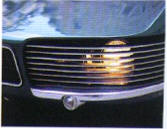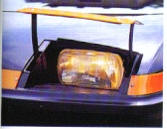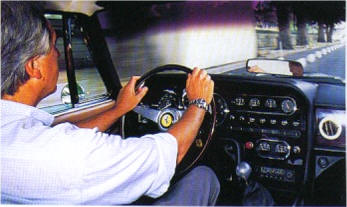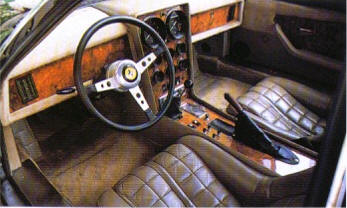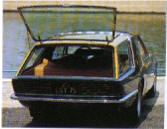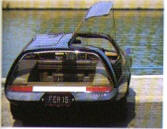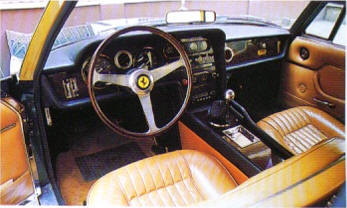 | 330 GT Registry |  |
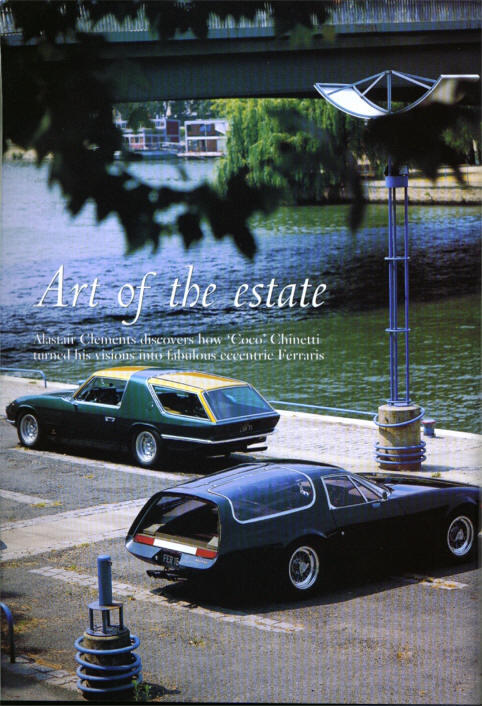
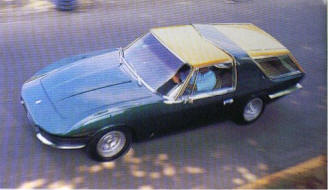 |
| 'When I heard someone say: “You got something different?” I’d reply: “Well pen it right up, what would you like?” My work was a great deal of fun’ |
Everyone has tried their hand at car design — be it a napkin doodle or improvements drawn on to the latest offerings in Autocar. But only the privileged few have the opportunity to turn those dreams into metal. Luigi Chinetti Jr, son of the famous East Coast Ferrari importer and racer, is one of those few. Like his father, who commissioned scores of bespoke dropheads, ‘Coco’ favoured Ferrari for his projects, choosing top coachbuilders to put quirky designs on to the road. These exclusive machines weren’t just whims, but destined for Chinetti’s customers, as he explains: “I would not hesitate anytime I heard someone say: ‘You got something different?’ I’d reply: ‘we’ll pen it up, what would you like?’ That was my daily work, it was a great deal of fun.”
Like most dreamers, Chinetti’s fantasy was supercars —with a twist. “I don’t consider them estates,” he says. “To me they’re more extended coupés like the Volvo 1800. I always thought it would be a nice solution to put on a Ferrari.” First of these ultimate shooting brakes was based on Ferrari 330GT two-plus-two chassis 07963, one of three special-bodied 330s, all of which were commissioned by the Chinettis. For Coco, the choice of coachbuilder was obvious: “If you were making a race car then Zagato would be fine — or Scaglietti, Drogo, Fantuzzi or any number of others — but the station wagon was designed for a client in America, and American standards were far more critical. We went over to Italy to see Alfredo Vignale, be was a very impressive man. Dad used to do a great deal of work with him in the ‘50s — I remember he made a car from start to finish in under three weeks, which was unbelievable.”
Vignale's flashy style perfectly suited the glitzy wagon and it was built around one of the last 330GTs. The shooting brake was completed to Chinetti’s design, retaining only the windscreen and part of the coupé’s doors, in time to appear on the Vignale stand at the ‘68 Turin Salon before it was shipped to the USA. “It came out pretty much as advertised considering we didn’t build a model,” Coco recalls. “And the finish was superb. The colour combination was chosen by Bob Peak and I, it was originally Marrona Colorado — a bit like Rolls-Royce Sable.”
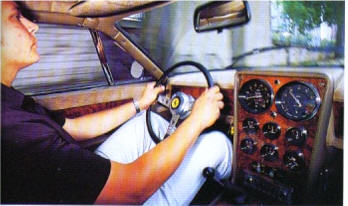 | 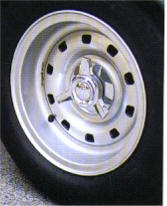 |
| |
Bruising Daytona loses little of the originals punch, despite weight claims of up to 3700lb,with sharp, unassisted steering; gorgeous Borrani wires; bizarre flaps conceal single headlamps | 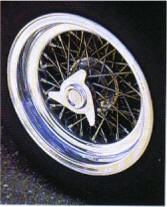 |
| |
It was to he Alfredo Vignale’s last Ferrari. The great man died in an accident in his Maserati in November 1969 and the firm merged with Ghia before disappearing into the folds of the Ford Motor Company, which closed the Turin factory in 1975.
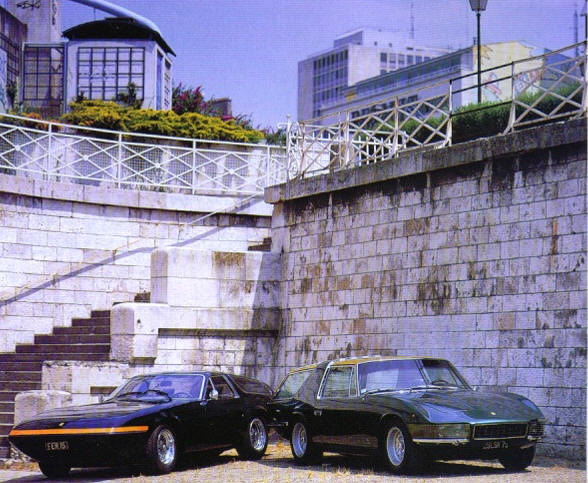
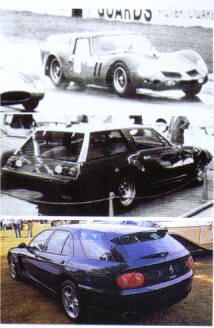 FROM VAN ROUGE TO 456 FROM VAN ROUGE TO 456Not strictly an estate, but the 1962 Ferrari 250SWB ‘Breadvan’ or Comionette looked like one thanks to its flat roofline and Kamm tail designed by former Ferrari engineer Giotto Bizzarrini. The Breadvan was built for Count Volpi di Misurata of Scuderia Serenissima when he wanted a second car to run alongside his new GTO. Neri e Bonaccini constructed it using chassis 2819GT with the engine dry sumped and moved back and down in the modified chassis. The vehicle was later civilised with bumpers and a rear window wiper to become a road car. The second car was another Robert Jankel build, this time for Willy Felber to a design by Giovanni Michelotti. Called the 'Croisette’ and based on a 365 GTC/4, the practical-looking if not particularly handsome two-seater, three-door shooting brake was shown at the 1977 Geneva Salon. ’The only other individual we worked for, aside from Chinetti, was Willy Felber in Switzerland’ Jankel recalls. In the mid-1990s,Carrozzeria Pininfarina of Turin designed and beautifully built a range of nine ‘Venezia’ cabriolets, saloons and station wagons for the Brunei royal family, based on the fabulous Ferrari 456GTA.The stunning five-door estate has a 200mm longer wheelbase than the standard two-plus-two coupé and is a full four-seater, with a redesigned interior in green leather to match the Forest Green paintwork. It runs the standard 5.5-litre V l2.There are also reports of an estate based on the 400i, but no pictures have been traced. |
Sitting on handsome Campagnolo alloys, the Vignale is far more attractive in the metal than in photos, hut is still somewhat awkward. “If I did the Vignale over I would have tried to adapt another windshield,” Chinetti says. “I was young and didn’t insist upon a lot of things; had I been able to use a more fluid windshield I would have been a happy man.” A heavy roll hoop, peppered with vents, splits the roof in two and gives a hint of Jensen Interceptor to the side profile and, like the Brit, the Ferrari looks exceptionally long. Four round headlights are concealed behind chromed strips, matched by similar items to the rear. Another unusual detail is the pronounced crease leading along the front wing tops, which flattens before meeting the windscreen.
In the early ‘70s, real estate developer Bob Gittleman strolled into Chinetti Motors asking for something a bit different — and Coco was only too happy to oblige. What could be more individual than a Ferrari Daytona estate? Industrial designer Gene Garfinkle has often been credited with designing this outrageous Dan Dare-style machine, much to Chinetti’s indignation: “Garfinkle did the rendering, he did not pen the car at all, it was completely my design.” With the drawings completed, Coco had to decide who would build it. “We were distributors for Panther Cars in those days,” he explains. “We’d been over there and it was a nice quality shop. I said: ‘Why don’t we make the first Ferrari made in England?”
So Ferrari 365GTB/4 chassis 15275 was despatched to Robert Jankel’s Panther Westwinds in Surrey. “It was pretty straightforward,” Jankel recalls. “We got some rough sketches and had to interpret them and basically design the car. He didn’t specify how it should be finished, but it had a very exotic interior.” Jankel obviously enjoyed working with the charismatic American over the three-month build: “It was rare for us to build a car like that — we took quite a bit of persuading. Lui’s a charming bloke and easy to work with. He let us get on with it because he trusted us.”
The Daytona sport wagon was completed before the end of 1975, but the planned motor ‘s never fitted, despite claims in Panther winds’ press release: ‘Luigi Chinetti Jr of NART has just taken delivery of this beautiful car specially built by Panther. This ultimate of cars is powered by a 600bhp turbocharged Ferrari Daytona V 12 engine, which pushes the car up to 230mph.’ The mad engine was probably out for a couple of reasons. “The price turned out to be more expensive than Vignale’s by a fair bit,” says Chinetti. Another consideration is the car’s aerodynamics, which cause the front end to float as speeds rise above 125mph. ‘I would expect that a little bit higher, but it wouldn’t surprise me,” says Chinetti. “It’s obviously because Jankel didn’t respect the original hood profile, he made it a little flat.”
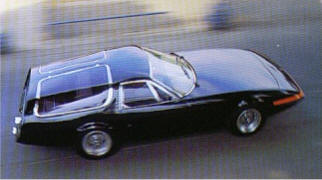 'While the 330 is restrained elegance, the Daytona is pure theatre... The finish is more Marcos than Maranello, all burr walnut and Connolly hide’ |
That long yet slightly uncomfortable nose is tipped with strange flip-up panels — hiding fixed lights — and crude orange trim, whose exposed screwheads betray the car’s bespoke build. Despite giving a ‘superhearse’ look, the glossy black paintwork hides the substantial impact bumpers, wooden at the front and plastic at the rear. Both Chinetti and Jankel are proud of the sleek aluminium-bodied two-seater. “It was a beautiful car,” Jankel recalls. “The front was a lot like the Daytona, but was completely restyled. As far as I remember, only the windscreen, A-pillars and doors were kept.”
Chinetti is equally enthusiastic about his design, but more realistic: “The whole hood should be sloped down more to avoid the whale look at the front. But the back of the car is super, much like a Kamm tail — the idea for that me from the GTZ Alfas. And the light trim the front is nice. You can pick it apart, bur it sows that it was not designed by committee — any problems you can blame on me.”
| FIRST ATTEMPT WAS PRECURSOR TO RESTAURANT DESIGN Coco Chinetti’s first design, in conjunction with illustrator Robert Peak, was this Ferrari 275 which made its debut at the 1967 New York International Automobile Show. Sold under the banner of Chinetti/Peak Research/Design Ltd, the swoopy steel-bodied car was built by Giovanni Michelotti. “It was the 275P that had won at Sebring and we put a gullwing body on it" Chinetti explains. “It was on the cover of Car & Driver and was painted silver. I still have the original body but I put the car, which I also still have, back to 275P specification. I’d always liked styling automobiles, and on the 275P I had a partnership with Bob Peak. Besides being a client of ours, Bob was a famous illustrator in the US. I had a drawing table setup in my office at Chinetti Motors and he started to paint cars and I said: 'Gee, I’d like to help you with this.’ He sponsored the first Michelotti, and concurrently with that we did the Vignale wagon." 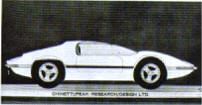 In the PR for the 275P, Robert Peak says: ‘Actually, we want to create restaurants, but we decided to create an automobile first to gain design experience.’ In the PR for the 275P, Robert Peak says: ‘Actually, we want to create restaurants, but we decided to create an automobile first to gain design experience.’ |
The car sits on Borrani wire wheels, shod with the same Michelin XWX 215/70x15s as the 330GT, despite factory shots showing disc wheels. “That was an experiment I drew up that probably was not a good idea,” Chinetti adds. “It made it look very funereal.” But the Ferrari’s most distinctive feature is its rear, with twin Perspex ‘butterfly’ panels for accessing the walnut-lined load bay. Chinetti explains the reasoning: “If you were shopping, if you park like normal people do here, you can’t get access to the back of a wagon. Whereas loading it from the side you always get some sort of access. And it was safer because I never liked being between two parked cars with my legs between the bumpers. Bill Mitchell, who was head of styling at GM, did a styling exercise that lifted the entire back of the Daytona and put it on to a Pontiac Firebird. And it didn’t look bad at all — it would have made a very elegant automobile.”
So what are these supercar shopping trollies really like? A cursory glance is enough to see the 330’s build quality, from the solid door shuts to the coherence of the richly trimmed interior. The tan leather armchairs are standard 330GT, with claw marks on the passenger seat a legacy of a dog fanatic early owner who also added metal mutt — now thankfully removed .- on the bonnet. A neat badge on the glovebox lid proclaims Carrozzeria Vignale Exemplare Unique, just in case you’d forgotten you were in something a bit special, and the headlining contains a vee echoing that of the roll hoop outside. The high rear seats are surprisingly roomy and there’s a decent boot, dominated by the leather-trimmed fuel tanks.
The driver faces a large Veglia speedo and rev counter with an air vent between let into the near-standard 330GT dash. The huge Nardi wheel sits low, forcing splayed legs, yet is a delight and the driving position comfortable. Flick down the fuel and battery toggle switches, give the throttle a couple of pumps before turning the key, then the starter whirrs and the 3967cc V12 catches on the throttle, erupting with a wonderful metallic cacophony. Release the vintage-style handbrake on the right hand side of the footwell and, pulling away, the first things to strike you are the positive five-speed ‘box, powerful all-round Dunlop discs and light steering. The 330 has an atrocious lock, anything more than a relatively shallow bend requiring a three-point turn, but on the move the steering is sharp and responsive. Despite its triple twin-choke Weber 40-equipped V12 giving 300bhp, the extra weight of its bespoke steel coachwork makes the Vignale more regal than raw to drive, but it would be a practical and effective long-distance tourer.
| 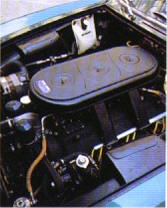 |
| |
Daytona retained just wheel and dials of original, though latter were herded together in centre console. Perspex gullwings give easy access to load bay; white panel illuminates in reverse | 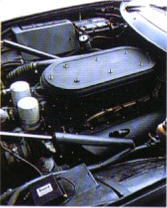 |
| |
While the 330 is all restrained elegance, the Daytona is pure theatre — a lesson in exotic finishing. “On both of the cars I really put a lot of effort into the interior,” Chinetti recalls. “In the Daytona the dashboard is basically the underside of the leather, so it’s a much rougher texture and anti-reflective.” Step over the kick-plate, complete with bewinged Panther logo, and it feels less complete than the solid 330, more show car than road car, but is far more exciting to look at and drive.
Inside, little remains of the original, just the leather-rimmed Momo wheel and traditional Veglia dials — though they are clustered on the central console. The variable finish is more Marcos than Maranello, all burr walnut and brown Connolly hide with a padded suede headlining — even the clutch footrest is trimmed in padded leather. With all that glazing, just a hint of sun turns the cabin into an oven so the air conditioning is a necessity. The driving position is more sporting than the 330’s, with a reclined seat and smaller, less upright wheel. The ignition is jammed against the centre console so the key needs to be inserted with your left hand unless you’re double-jointed, and it awakens that 4390cc V12 whose 352bhp always quickens the pulse.
It’s surprisingly easy to drive. The pedals are light and the slick dog-leg five-speed gearbox is pure Ferrari, even though it’s a remote transaxle. You can feel the lever clicking through the metal gate under the leather gaiter. The wagon is seriously quick and sounds fantastic, with a classic V12 howl from those big twin tailpipes. Once on the move, the unassisted recirculating ball steering is a delight and the car never feels heavy, despite weight claims of up to 3700lb. “The race Daytona couldn’t go below a certain percentage of a standard car,” recalls Chinetti. “Ferrari built a homologation special that included air conditioning and glass windows — that really helped us out a lot!”
For all its faults, this fascinating duo is a throwback to an era of customisation and the art of coachbuilding that is unlikely to return. “In those days it was fun, you could do things like that,” Chinetti concludes ruefully. “Today most of the cars look the same because they’ve all been through the same filter.”
Thanks to Simon Kidston at Bonhams & Brooks Europe (0041 22 300 3160) and the owner 'Patch'.
Classic & Sports Car
Copyright 2001, Classic & Sports Car
Published with permission of Classic & Sports Car

